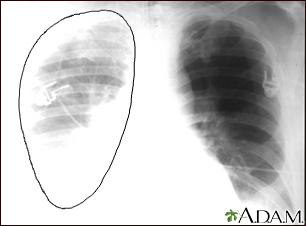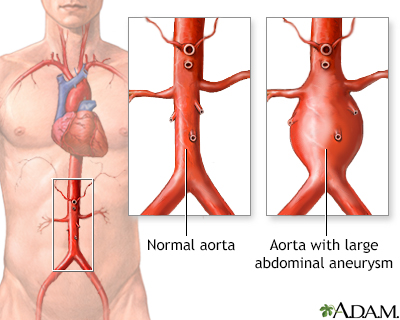AAA 0519142 UPDATED 100419
Aneurysm - aortic; AAA
THIS LINE IS A TEST OF EDIT CONTENT FUNCTION, TEXT CAN BE ADDED OR CHANGED IN ANY SECTION OF THE ARTICLE.
The aorta is the main blood vessel that supplies blood to the abdomen, pelvis, and legs. An abdominal aortic aneurysm occurs when an area of the aorta becomes very large or balloons out. Test content 051914JH
Images


Causes
The exact cause of the condition is unknown. Factors that can increase your risk of developing the problem include:
- Smoking
- High blood pressure
- Male gender
- Genetic factors
An abdominal aortic aneurysm is most often seen in males over age 60 who have one or more risk factors. The larger the aneurysm, the more likely it is to break open. This can be life-threatening.
Symptoms
Aneurysms can develop slowly over many years, often with no symptoms. Symptoms may come on quickly if the aneurysm expands rapidly, tears open or leaks blood within the wall of the vessel (aortic dissection).
Symptoms of rupture include:
- Pain in the abdomen or back. The pain may be severe, sudden, persistent, or constant. It may spread to the groin, buttocks, or legs.
- Passing out
- Clammy skin
- Dizziness
- Nausea and vomiting
- Rapid heart rate
- Shock
Exams and Tests
Your doctor will examine your abdomen and feel the pulses in your legs. The doctor may find:
- A lump (mass) in the abdomen
- Pulsating sensation in the abdomen
- Stiff or rigid abdomen
You may have an abdominal aortic aneurysm that is not causing any symptoms. Your doctor may find this problem by doing the following tests:
- Ultrasound of the abdomen when the abdominal aneurysm is first suspected
- CT scan of the abdomen to confirm the size of the aneurysm
- CTA (computed tomographic angiogram) to help with surgical planning
Any one of these tests may be done when you're having symptoms.
Treatment
If you have bleeding inside your body from an aortic aneurysm, you will need abdominal aortic aneurysm repair.
If the aneurysm is small and there are no symptoms:
- Surgery is rarely done.
- You and your doctor must decide if the risk of having surgery is smaller than the risk of bleeding if you do not have surgery.
- Your doctor may want to check the size of the aneurysm with ultrasound tests every 6 months.
Most of the time, surgery is done if the aneurysm is bigger than 2 inches (5.5 cm) across or growing quickly. The goal is to do surgery before complications develop.
There are two types of surgery:
- Traditional (open) repair. A large cut is made in your abdomen. The abnormal vessel is replaced with a graft made of man-made material.
- Endovascular stent grafting. This procedure can be done without making a large cut in your abdomen, so you may recover more quickly. This may be a safer approach if you have certain other medical problems. Endovascular repair can sometimes be done for a leaking or bleeding aneurysm.
Outlook (Prognosis)
The outcome is often good if you have surgery to repair the aneurysm before it ruptures.
When an abdominal aortic aneurysm begins to tear or ruptures, it is a medical emergency. Only about 1 in 5 patients survive a ruptured abdominal aneurysm.
When to Contact a Medical Professional
Go to the emergency room or call 911 if you have pain in your belly or back that is very bad or does not go away.
Prevention
To reduce the risk of aneurysms:
- Eat a heart-healthy diet, exercise, stop smoking (if you smoke), and reduce stress.
- If you have high blood pressure or diabetes, take your medicines as your doctor has told you.
People over age 65 who have ever smoked should have a screening ultrasound done once.
Related Information
High blood pressure in adults - hypertensionAneurysm
Aortic dissection
Hypovolemic shock
Arterial embolism
Causes
Heart attack
Heart attack - test
Stroke
Aortic aneurysm repair - endovascular
Abdominal aortic aneurysm repair - open
Aortic aneurysm repair - endovascular - discharge
Abdominal aortic aneurysm repair - open - discharge
BACK TO TOP

Health Content Provider
06/01/2028
|
A.D.A.M., Inc. is certified by URAC, for Health Content Provider (www.urac.org). URAC's certification program is an independent audit to verify that A.D.A.M. follows rigorous standards of quality and accountability. A.D.A.M. is among the first to achieve this important distinction for online health information and services. Learn more about A.D.A.M.'s editorial policy, editorial process and privacy policy. |
The information provided herein should not be used during any medical emergency or for the diagnosis or treatment of any medical condition. A licensed medical professional should be consulted for diagnosis and treatment of any and all medical conditions. Links to other sites are provided for information only -- they do not constitute endorsements of those other sites. © 1997- 2025 A.D.A.M., a business unit of Ebix, Inc. Any duplication or distribution of the information contained herein is strictly prohibited.
